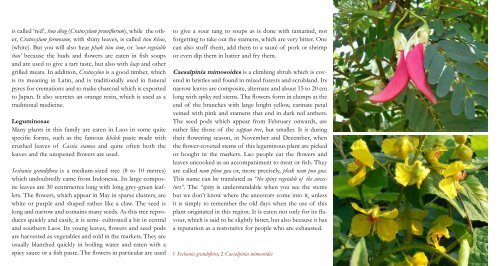Create successful ePaper yourself
Turn your PDF publications into a flip-book with our unique Google optimized e-Paper software.
is called ‘red’, tiou dèng (Cratoxylum pruniflorum), while the other,<br />
Cratoxylum formosum, with shiny leaves, is called tiou khao,<br />
(white). But you will also hear phak tiou som, or ‘sour vegetable<br />
tiou’ because the buds and flowers are eaten in fish soups<br />
and are used to give a tart taste, but also with laap and other<br />
grilled meats. In addition, Cratoxylon is a good timber, which<br />
is its meaning in Latin, and is traditionally used in funeral<br />
pyres for cremations and to make charcoal which is exported<br />
to Japan. It also secretes an orange resin, which is used as a<br />
traditional medicine.<br />
Leguminosae<br />
Many plants in this family are eaten in Laos in some quite<br />
specific forms, such as the famous khilek paste made with<br />
crushed leaves of Cassia siamea and quite often both the<br />
leaves and the unopened flowers are used.<br />
Sesbania grandiflora is a medium-sized tree (8 to 10 metres)<br />
which undoubtedly came from Indonesia. Its large composite<br />
leaves are 30 centimetres long with long grey-green leaflets.<br />
The flowers, which appear in May in sparse clusters, are<br />
white or purple and shaped rather like a claw. The seed is<br />
long and narrow and contains many seeds. As this tree reproduces<br />
quickly and easily, it is semi- cultivated a bit in central<br />
and southern Laos. Its young leaves, flowers and seed pods<br />
are harvested as vegetables and sold in the markets. They are<br />
usually blanched quickly in boiling water and eaten with a<br />
spicy sauce or a fish paste. The flowers in particular are used<br />
to give a sour tang to soups as is done with tamarind, not<br />
forgetting to take out the stamens, which are very bitter. One<br />
can also stuff them, add them to a sauté of pork or shrimp<br />
or even dip them in batter and fry them.<br />
Caesalpinia mimosoides is a climbing shrub which is covered<br />
in bristles and found in mixed forests and scrubland. Its<br />
narrow leaves are composite, alternate and about 15 to 20 cm<br />
long with spiky red stems. The flowers form in clumps at the<br />
end of the branches with large bright yellow, carinate petal<br />
veined with pink and stamens that end in dark red anthers.<br />
The seed pods which appear from February onwards, are<br />
rather like those of the sappan tree, but smaller. It is during<br />
their flowering season, in November and December, when<br />
the flower-covered stems of this leguminous plant are picked<br />
or bought in the markets. Lao people eat the flowers and<br />
leaves uncooked as an accompaniment to meat or fish. They<br />
are called nam phou gna or, more precisely, phak nam pou gna.<br />
This name can be translated as “the spiny vegetable of the ancestors”.<br />
The “spiny is understandable when you see the stems<br />
but we don’t know where the ancestors come into it, unless<br />
it is simply to remember the old days when the use of this<br />
plant originated in this region. It is eaten not only for its flavour,<br />
which is said to be slightly bitter, but also because it has<br />
a reputation as a restorative for people who are exhausted.<br />
1 Sesbania grandiflora; 2 Caesalpinia mimosoîdes


